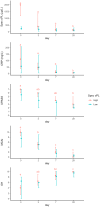Serial monitoring of pancreatic lipase immunoreactivity, C-reactive protein, abdominal ultrasonography, and clinical severity in dogs with suspected pancreatitis
- PMID: 38363021
- PMCID: PMC10937488
- DOI: 10.1111/jvim.17020
Serial monitoring of pancreatic lipase immunoreactivity, C-reactive protein, abdominal ultrasonography, and clinical severity in dogs with suspected pancreatitis
Abstract
Background: Diagnosis of pancreatitis is based on clinical signs, pancreatic lipase immunoreactivity (cPLI), and abdominal ultrasonography (AUS). Diagnostic discrepancies exist between test results which might be related to differences in the timeline for resolution of these abnormalities after pancreatic injury.
Hypothesis/objectives: To evaluate disease severity, ultrasonographic findings, and serum biomarkers of pancreatitis in dogs over a period of 28-days.
Animals: Sixteen client-owned dogs with a clinical suspicion for acute pancreatitis based on history/physical examination, an abnormal SNAP cPLI, and ultrasonographic evidence of pancreatitis.
Methods: Prospective observational study. Clinical severity (modified clinical activity index [MCAI]), cPLI, C-reactive protein (CRP), and AUS were evaluated at days 0, 2, 7, and 28. Owner assessed overall health (OH) was noted. Dogs were stratified into baseline cPLI ≥400 μg/L vs <400 μg/L groups for reporting.
Results: The median CRP, MCAI, and OH were 111.9 mg/L, 10, and 4/10 respectively in the cPLI ≥400 μg/L group. The median CRP, MCAI, and OH were 58.0 mg/L, 6, and 6/10 respectively in the cPLI <400 μg/L group. None of these variables were significantly different between groups. Most dogs (4/5) in the cPLI <400 μg/L group had a history of suspected pancreatitis (ie, suspect acute on chronic disease). cPLI and MCAI rapidly decreased in dogs with a baseline cPLI ≥400 μg/L, whereas sonographic evidence of pancreatitis persisted for a longer time period.
Conclusions and clinical importance: Ultrasonographic evidence of pancreatitis in the absence of overt clinical or biochemical abnormalities might represent a resolving injury rather than active disease.
Keywords: PLI; Spec cPL; immunoassay; monitoring; pancreas; ultrasound.
© 2024 The Authors. Journal of Veterinary Internal Medicine published by Wiley Periodicals LLC on behalf of American College of Veterinary Internal Medicine.
Conflict of interest statement
Authors declare no conflict of interest.
Figures


References
-
- Xenoulis PG. Diagnosis of pancreatitis in dogs and cats. J Small Anim Pract. 2015;56:13‐26. - PubMed
-
- Newman S, Steiner J, Woosley K, Barton L, Ruaux C, Williams D. Localization of pancreatic inflammation and necrosis in dogs. J Vet Intern Med. 2004;18:488‐493. - PubMed
-
- Steiner JM, Newman S, Xenoulis P, et al. Sensitivity of serum markers for pancreatitis in dogs with macroscopic evidence of pancreatitis. Vet Ther. 2008;9:263‐273. - PubMed
-
- Neilson‐Carley SC, Robertson JE, Newman SJ, et al. Specificity of a canine pancreas‐specific lipase assay for diagnosing pancreatitis in dogs without clinical or histologic evidence of the disease. Am J Vet Res. 2011;72:302‐307. - PubMed
Publication types
MeSH terms
Substances
Grants and funding
LinkOut - more resources
Full Text Sources
Medical
Research Materials
Miscellaneous

